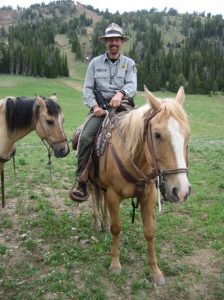
Backcountry Rangers brave the elements —and other dangers—to protect the park’s treasures.
WANTED: Man or woman with skills in horseback riding and backcountry skiing, willing to hike 20 miles at a time, and available to work 24 hours per day. Must be trained in search and rescue operations, emergency medical response, avalanche safety, and use of firearms. Should be handy with a shovel, ax, and saw, and have a high tolerance for extreme cold, deep snow, and wet conditions. Woodworking and sewing skills a plus.
The job of a Yellowstone backcountry ranger is a tradition dating back to the first U.S. Army soldiers who patrolled the park in the late 19th century. These versatile and hardy individuals are responsible for protecting resources year-round in wilderness areas, which make up 90% of Yellowstone’s 2.2 million acres. They must be extremely well-trained and prepared to deal with a diverse mix of age-old challenges and more modern problems.
Jamie Hanson is the Gallatin Backcountry Supervisor in the park’s West District, one of seven ranger districts. It’s a big job, in more ways than one. With just one seasonal ranger and a couple volunteers who assist him during the summer months, Hanson is responsible for monitoring a vast area of 500 square miles, with 130 miles of trails and 30 campsites.
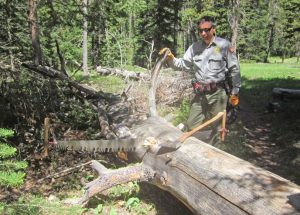 Covering Ground
Covering Ground
Yellowstone rangers monitor the backcountry on patrols ranging from one to ten days, watching for any risks to wildlife, visitors, or the natural landscape. Since motorized vehicles are prohibited from trails, they travel by foot, horseback, skis, or snowshoes. Hanson estimates that during a summer season he logs 300-400 miles on foot, and another 400-500 miles on horseback.
Though Hanson explains that while “there is no day that is the same as any other day,” there are some daily duties that characterize each season in the park.
Spring involves plenty of manual labor in the form of trail clearing, often requiring 14- to 16-hour days. Rangers typically spend four to six weeks removing brush and downed trees to make way for visitors and horses, and to assess any trail damage that will require repair. They prepare backcountry campsites by digging pit toilets and hanging food poles.
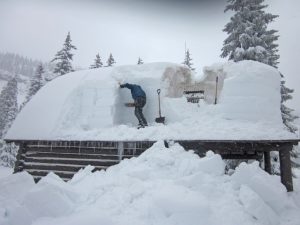 When summer arrives, so do most of the year’s visitors, so rangers make frequent rounds to backcountry campsites to clean fire pits and ensure that fire and food-storage regulations are followed. They also check for any fishing violations such as fishing without a permit, using improper tackle, or keeping too many or the wrong kind of fish.
When summer arrives, so do most of the year’s visitors, so rangers make frequent rounds to backcountry campsites to clean fire pits and ensure that fire and food-storage regulations are followed. They also check for any fishing violations such as fishing without a permit, using improper tackle, or keeping too many or the wrong kind of fish.
A primary concern throughout the autumn months is detecting and deterring the poaching of wildlife. Elk within Yellowstone, but close to park boundaries, are at particular risk.
In the winter, snowmobile incursions can be a serious problem. Last winter, rangers cited 30 such violations in the park where there are no permitted roads and trails. Some of the most egregious violations involved riding in fragile thermal areas, across the tops of young trees, and even over the roofs of historic cabins. Yellowstone Forever (formerly the Yellowstone Association and Yellowstone Park Foundation) has funded high-performance powder snowmobiles for rangers to travel park boundaries, detecting and deterring incursions.
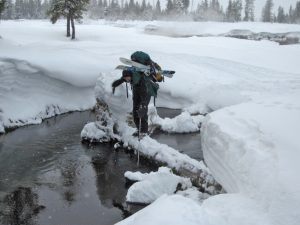 Risky Business
Risky Business
“It’s an amazing job to have,” insists Hanson, though he admits that certain hazards come with the territory. Some are environmental, such as -30F temperatures, or the occasional need to cross a river in chest-deep water. Others relate to helping visitors in peril; backcountry rangers are often first responders in a medical emergency or search-and-rescue operation, and must confront any accompanying dangers such as avalanches or steep terrain.
But the biggest danger, says Hanson, is the same as for any law enforcement officer: people. The park’s backcountry rangers are federal officers who carry guns and are required to attend a law enforcement academy. Yellowstone even has its own jail, court, and magistrate to handle a wide variety of offenses.
“We sometimes need to make arrests, fend off physical assaults, or confront poachers who have high-powered rifles.”
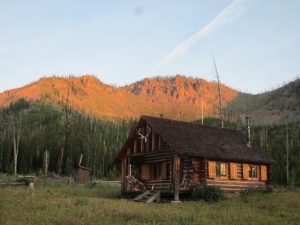 Home Base
Home Base
When each day’s work is finally done, nights are spent in rustic backcountry cabins, many of which are historic and have been used by rangers for decades. Rangers carry their own supplies to the cabins from the nearest road, which might not be so near. They collect and chop the firewood to burn in woodstoves, the only heat source for the cabins, which also have no electricity or plumbing.
To help support the important work of these rangers, Yellowstone Forever has funded several projects to repair and restore historic ranger cabins and make safety-related upgrades to shelters used by rangers on patrol. Recent examples include the installation of a metal roof to better withstand heavy snowfall at the Three Rivers Cabin, and the purchase of wall tents for rangers patrolling the remote Skyrim area.
The Ranger Tradition
“If I were to meet one of the first Yellowstone rangers from when the park was first established, my job would look very familiar to them,” said Hanson. “The work of the backcountry ranger hasn’t changed a lot. There are no cars. We don’t see the heavy visitation that occurs in the front country.”
Hanson explains that despite the occasional contact with modern technology, the position still requires many time-honored ranger skills.
“The Park Service looks for candidates with a wide variety of traditional skills and experience, but those are getting harder to find now that we live in more of an electronic society,” said Hanson. “Fewer people have experience riding a horse or performing heavy physical labor. Even skills like sewing and chopping wood are more rare.”
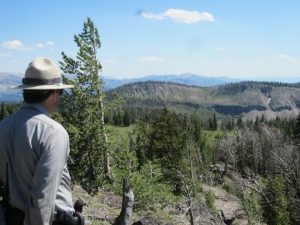 According to Hanson, character strengths are equally important, such as a good attitude and work ethic, a willingness to learn, and the ability to work independently and problem-solve. And of course, an unyielding commitment to protecting Yellowstone is essential.
According to Hanson, character strengths are equally important, such as a good attitude and work ethic, a willingness to learn, and the ability to work independently and problem-solve. And of course, an unyielding commitment to protecting Yellowstone is essential.
“The ranger tradition in Yellowstone has endured. It is one of the main things that draws me to be here.”
Through the Ranger Heritage Initiative, Yellowstone Forever supports projects that promote the effectiveness, safety, and efficiency of rangers, and preserves the tradition of rangers in Yellowstone.
All photos courtesy of NPS. Top to Bottom: Ranger Jamie Hanson on horseback; Ranger George Kittrell uses a crosscut saw on a downed tree; Ranger Stan Dominik clears snow off the Three Rivers Cabin; Ranger Mike Ross on a ski patrol in the Bechler; the Sportsman Cabin in the Gallatin backcountry; Ranger Jamie Hanson looks out over the Gallatin backcountry.
By Christine Gianas Weinheimer
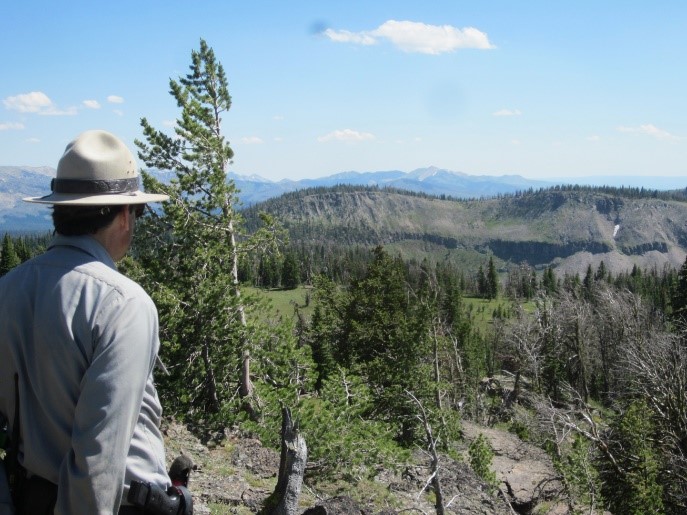
Comments are closed.